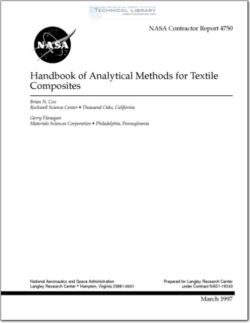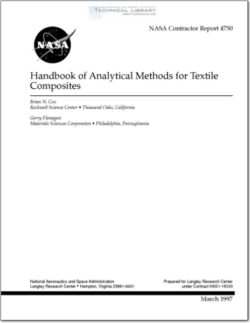NASA-CR-4750

- Version
- 648 Downloads
- 2.24 MB File Size
- 1 File Count
- April 6, 2016 Create Date
- April 6, 2016 Last Updated
Handbook of Analytical Methods for Textile Composites

1 .0 INTRODUCTION
1 . 1 Scope
The purpose of this handbook is to introduce models and computer codes for
predicting the properties of textile composites. The composites of primary interest are those
best suited to applications in aircraft structures. This is first to say those ranked high in
stiffness and strength; and many models are therefore discussed which detail the elastic
regime and predict the proportional limit. But textile composites are also favoured for their
superior damage tolerance. The handbook therefore includes several models for predicting
the stress-strain response all the way to ultimate failure; methods for assessing work of
fracture and notch sensitivity; and design rules for avoiding certain critical mechanisms of
failure, such as delamination, by proper textile design.
The textile classes receiving at least some treatment are:
(i) 2D woven laminates
(ii) 2D braided laminates
(iii) laminates of knitted plies
(iv) stitched laminates
(v) 3D interlock weaves
(vi) 3D braids
(vii) 3D nonwoven composites.
The fiber and matrix materials need not be specified until the models are applied to a
particular material. However, many models are based on assumptions that may be invalid if
the degree of anisotropy is not as high as it is for stiff fibers such as carbon or glass in a
polymeric matrix. Models assuming high anisotropy would not be appropriate for ceramic
or metal matrix composites. Readers working with ceramics or metals should exercise
caution accordingly.
The handbook deals mainly with models for textile composites manufactured as flat
panels, with limited attention to curved panels. Yet one of the longer term attractions of
textiles is that they promise a method of manufacturing net shape, integral structures,
eliminating many machining and joining steps in manufacture, cutting material waste,
| File | Action |
|---|---|
| NASA-CR-4750 Handbook of Analytical Methods for Textile Composites.pdf | Download |

Comment On This Post